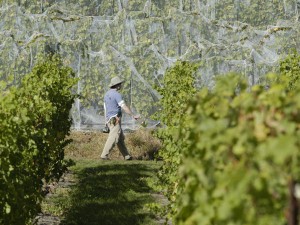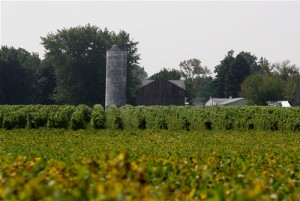Offbeat European Grapes Growing Across the Midwest

Black Star Farms Winery (photo courtesy of the winery)
Increasingly, Midwestern winemakers are defying convention by growing popular vinifera grapes like Cabernet Sauvignon or Cabernet Franc. But in recent years, a number of vineyards have planted lesser known European grapes considered offbeat for the Midwest, like Gruner Veltliner and Teroldego.
An example of an adventurous viticulturalist is Nick Ferrante, owner of Ferrante Winery in Harpersfield Town, Ohio. Ferrante wanted to produce a wine from grapes grown in Ohio that would reflect his Italian heritage. So this spring, he planted Dolcetto.
Dolcetto originates from the Piedmont region of northern Italy, and while it is sometimes grown in California — Ferrante sourced his vines from Santa Rosa – it’s virtually unheard of in the Midwest. Literally translated, Dolcetto means ‘little sweet one,” but Dolcetto generally presents as a dry, light bodied, jammy, fruity wine.
Ferrante says his Dolcetto wine will be ‘dry, fruit forward with some barrel aging.” He’s confident that Dolcetto can ripen along Lake Erie, however Ferrante does have some concerns about Dolcetto’s winter hardiness. The young vines survived this year’s dry conditions and if all goes well, he expects to be producing Ferrante’s first Dolcetto wine in 2016.
To continue reading this post, you must either subscribe or login.[login_form][show_to accesslevel=”annual-membership” ]
Some wineries in Michigan and New York State are cultivating another Italian varietal that’s virtually unknown to American drinkers, this one especially well-suited to colder climates: Teroldego. The grape originates from the far north-east of Italy on the Alpine border region with Switzerland and Austria. Red Tail Ridge Winery in the Finger Lakes makes a sparkling Teroldego and also a still red that they describe as having, ‘Concentrated strawberry and blackberry jam aromatics laced with anise and brown spices.”
At Black Star Farms in Michigan, head winemaker Lee Lutes says they were inspired to plant Teroldego because of successful trial plantings by Michigan State University (MSU). About five years ago, MSU’s Viticulture Research and Extension Program, led by Dr. Paolo Sabbatini, planted several experimental vines including Teroldego and Lagrein, another northern Italian red grape. Lutes tasted Teroldego wine made from the university’s grapes the night before speaking with Midwest Wine Press and said it was “extremely promising” with bright colored, deep blue hues and intense flavors like deep plums and blackberry.
Black Star Farms now has a four acre block with about 1500 Teroldego vines, as well as Lagrein and two muscat varieties. These young vines are not producing fruit yet but survived this year’s severe frosts and the recent drought. Given how cold it can get in northern Italy, Lutes says he wasn’t surprised and says Teroldego’s survival through Midwest frost and drought, “gives us food for thought.”
Patty Ribic of Harpersfield Winery in Northeast Ohio planted an acre of the white grape Gruner Veltliner in 2006 because her family loves the taste of wine from this grape. The central European variety is common in Austria, Slovakia and the Czech Republic, but is also grown in Germany and as far afield as New Zealand. Ribic describes the flavor as, ‘ripe fruit, refreshing, lots of depth and complexity with acid balance…it’s like nothing else!”
Harpersfield’s vines came from a local farmer who sourced Gruner Veltliner from Canada. Ribic says the vines have been doing very well (so has their Gruner Veltliner wine — it’s sold out) but she says they do have to be careful with frost because this variety doesn’t grow secondary buds. However, despite the Spring frost and drought this year, the crop ‘did okay” and they expect to be harvesting during the middle of September, a couple of weeks early.
“it’s like nothing else!”
Patty Ribic of Harpersfield Winery, Ohio, referring to the Gruner Veltliner grape variety
In south-east Missouri, River Ridge Winery owners Jerry and Joannie Smith are probably the only vineyard in Missouri that grows another lesser known Italian grape, Refosco. This varietal comes from the north-eastern Friuli and Veneto regions. Like Amigoni Winery in Kansas City, River Ridge has bucked the Missouri winery trend of planting American hybrids and native cultivars and specializes in growing European vinifera including Cabernet Sauvignon, Cabernet Franc and Chardonnay. Refosco produces a dry, powerful, tannic red wine with good acidity that grows in complexity with bottle aging. It’s thought to be one of the older varietals in Italy and some wine experts link it to the ancient Roman Puccinum grape. (For more on Refosco’s history see: http://renraeretire.blogspot.com/2012/05/exciting-wine-new-to-me-but-not-to.html)
Another slightly offbeat grape for the Midwest, the Tempranillo varietal, known for producing Spain’s famous Rioja wine, is taking root in Ohio. At Hermes Winery in Sandusky, winemaker David Kraus says they imported very young Tempranillo vines from Spain and have successfully produced a dry red for several years. The Tempranillo grape is known for its adaptability and is grown all over Spain, from the dry, sandy soils of the large La Mancha region in the center of the country, to more alluvial soils found in the Ribera del Duero area north of Madrid. In Ohio, Kraus says their Tempranillo vines are doing well in their very rich soils that have good access to water.
[/show_to][password-recovery-link text=’Lost Password? Click here for password recovery.’]
[wp_geo_map]



